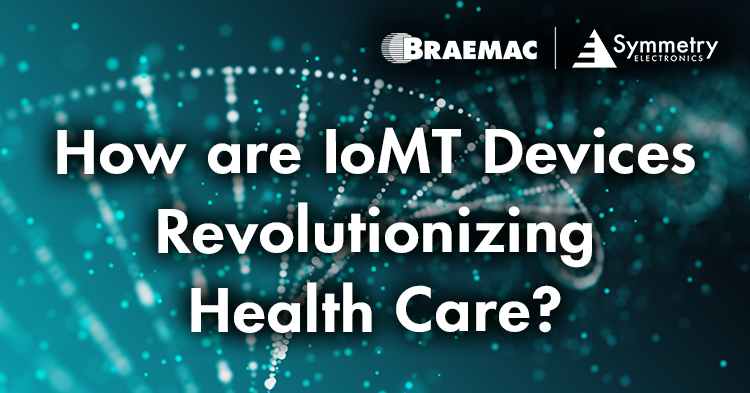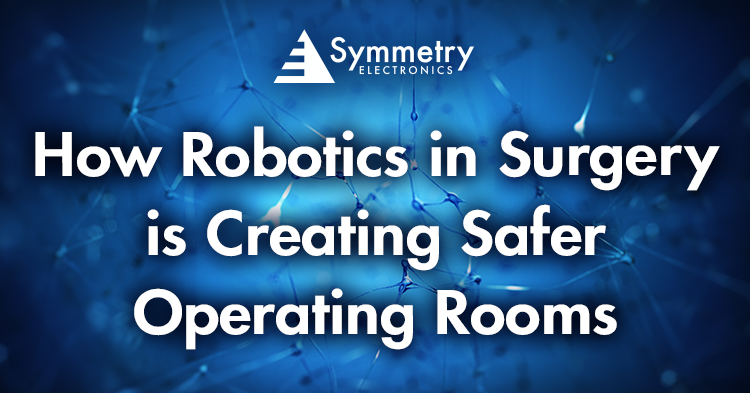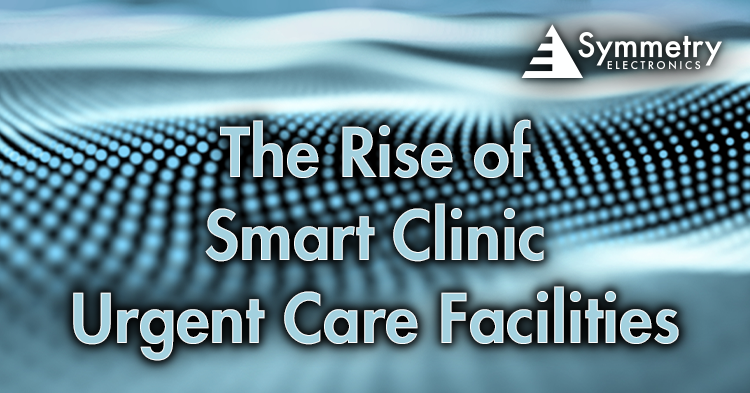- Home
- Symmetry Blog
- How are IoMT Devices Revolutionizing Health Care?
How are IoMT Devices Revolutionizing Health Care?
About Braemac Americas Team

Thanks to digitalization and IoT, healthcare is more personalized, proactive, and accessible than ever before. Connected technologies are transforming patient care and streamlining facility operations by enabling real-time remote monitoring, leveraging AI-driven diagnostics, and reshaping how medical data is collected, analyzed, and applied.
What is the Internet of Medical Things (IoMT)?
The Internet of Medical Things (IoMT) refers to the space where IoT and the healthcare industry converge. IoMT refers to connected ecosystems within medical environments that communicate, transmit, and analyze data in real-time. Driven by the increased demand for more intelligent healthcare solutions, the global IoMT market is expected to reach $814 billion by 2032.
Moreover, Market.us Media cites that over 83% of healthcare organizations have adopted or are planning to adopt IoMT solutions by 2022. Approximately 64% of patients use at least one IoMT device in their daily lives.
This widespread adoption is creating a more connected and data-rich healthcare ecosystem, laying the foundation for truly smart healthcare systems. The rapid growth of IoMT presents a unique opportunity for developers to create innovative smart healthcare solutions. These solutions often leverage a variety of IoMT devices, including:
- Wearables, including smartwatches, ECG monitors, and fitness trackers
- Remote monitoring tools such as blood pressure cuffs and glucose monitors
- In-hospital equipment like including smart infusion pumps and connected imaging systems
- Smart pills with ingestible sensors that transmit data from inside the body
- Mobility aids like smart wheelchairs and prosthetics

3 Reasons Why Healthcare Organizations Adopt Smart Health Solutions
Better Patient Outcomes
IoMT devices provide real-time insights that help clinicians make faster, more accurate diagnoses. They also empower patients to take control of their health, improving adherence to treatment plans and enabling early intervention.
Cost Reduction
According to the Centers for Medicare and Medicaid Services, the U.S. healthcare system spent an average of $14,570 per person in 2023. IoMT can reduce these costs by shifting care from hospitals to homes, enabling preventive care, and minimizing unnecessary visits.
Enhanced Patient Satisfaction
Patients benefit from fewer clinic visits, more personalized care, and greater convenience. This leads to higher satisfaction and better engagement with their health.
Popular IoMT Applications and Use Cases
Connected ecosystems in healthcare environments are well-suited for a wide range of application and use cases. Smart healthcare is becoming more responsive, data-driven, and patient-centric. Common IoMT applications include:
- Remote patient monitoring (RPM)
- Real-time data insights and anomaly detection
- Automated alerts
- Asset tracking
Recent advancements in tech are rapidly pushing the boundaries on what IoMT and connected healthcare technology is capable of. Trending use cases of IoMT include:
Edge Computing for Real-Time Decisions
By enabling devices to locally process data rather than at distant servers, edge computing reduces latency. It allows for faster data analysis and response times, especially critical in healthcare where emergency scenarios require lifesaving, real-time insights. For example, some wearable monitors can instantly alert clinicians to abnormal heart rhythms without waiting for cloud-based processing.
AI-Driven Diagnostics and Predictive Analytics
AI is being adopted across healthcare in 2025 to enhance diagnostics, streamline clinical workflows, and deliver predictive insights. These innovations are especially impactful in chronic care, where AI helps forecast complications and personalize treatment. For instance, a 2024 from Nature Cancer detailed how AI -powered tools can analyze large genomics data to predict survival outcomes of pancreatic cancer patients.
Connected Implants and Surgical Tools
Beyond wearables, 2025 has seen a rise in connected implants such as pacemakers that transmit real-time data and smart surgical tools that provide feedback during procedures.
Cleveland Clinic describes how direct pacemaker monitoring via smartphone has significantly improved data transmission success rates and patient engagement. This innovation is based on Medtronic’s BlueSync® technology, which uses low-energy Bluetooth® to connect pacemakers directly to a patient’s smartphone or tablet through the MyCareLink Heart™ app.
Key Considerations of IoMT Device Designs
Despite the growing momentum of IoMT, it is not without its challenges. As developers and designers work to launch future-proof connected health innovations, several critical considerations must be addressed to ensure safety, reliability, and effectiveness:

Security
Data security is critical to protect sensitive health information. IoMT devices are vulnerable to data security issues due to their reliance on wireless communication, limited processing power, and inconsistent security standards across manufacturers. Connected medical devices often transmit sensitive health data over networks that can be intercepted if not properly encrypted. Many lack the capacity for strong security features, and some may not receive regular updates, leaving them exposed to known threats. Additionally, integration with hospital systems and user behaviors like weak passwords can further increase the risk of cyberattacks and data breaches.
Compliance Standards
Regulatory compliance for IoMT devices is complex and time-consuming. IoMT devices must meet strict and often overlapping standards for safety, effectiveness, data privacy, and cybersecurity. They handle sensitive patient data and must comply with evolving regulations from multiple agencies like the FDA and HIPAA, as well as international bodies.
The broad range of IoMT devices, each with distinct functions and risk levels, adds to the complexity, as does the need for secure integration with healthcare systems. Navigating these diverse and changing requirements across global markets significantly extends development and approval timelines.
Interoperability
Interoperability is a significant challenge for IoMT devices due to various data formats and communication protocols. Without standardization, data sharing becomes fragmented, leading to inefficiencies, potential errors, and barriers to coordinated care. Ensuring secure, real-time, and accurate data exchange across platforms remains a major hurdle in fully realizing the benefits of connected healthcare.
The Matter protocol, originally developed to unify smart home ecosystems, it is now being explored for use in smart health applications as well. However, while Matter shows promise in healthcare, it is still early in its adoption for regulated medical devices, and it does not yet address all the security, privacy, and compliance requirements specific to the IoMT sector.
Overcoming Smart Health Development Challenges with Solutions at Braemac Americas
At Braemac Americas | Symmetry Electronics, we support developers with innovative solutions designed to meet the intelligence, connectivity, and scalability IoMT innovations require. As trusted industry experts, we are uniquely positioned to help developers overcome technical hurdles and ensure optimal performance in smart health and connected medical device designs.
Our curated portfolio includes in-stock, available components specifically designed to support the advanced processing, secure connectivity, and seamless integration required for today’s most demanding IoMT applications. From ultra-low-power microcontrollers to robust wireless modules and scalable cloud-ready platforms, our solutions help accelerate development and ensure long-term reliability in connected healthcare environments.
The IRIS-W10 series from u-blox is purpose-built for compact, low-power wireless applications. Integrating IRIS-W10 modules, these kits support dual-band Wi-Fi 6, Bluetooth® Low Energy 5.4, and Thread connectivity, making them ideal for medical wearables, portable diagnostics, and smart monitoring devices. A powerful onboard MCU enables advanced edge processing, while robust security features ensure safe data transmission in healthcare environments.
The Digi ConnectCore® MP2 development kit is a compact, industrial-grade platform for building secure, connected IoMT devices. Featuring a high-performance STM32MP25 processor, integrated Wi-Fi 6, Bluetooth 5.4, and Digi TrustFence® security framework, it supports edge AI, computer vision, and time-sensitive networking. This kit is ideal for developers creating next-generation smart devices and battery-powered applications..





.png)
